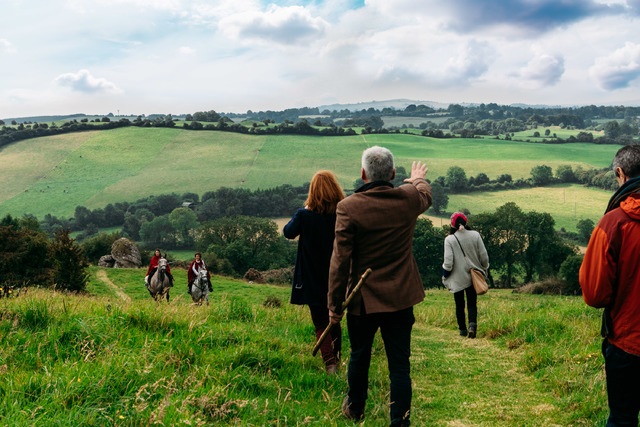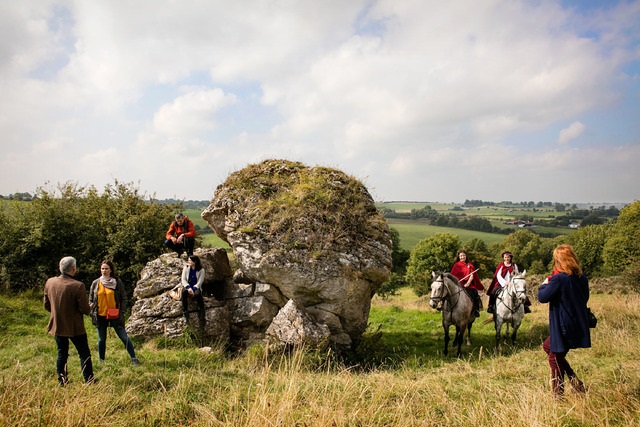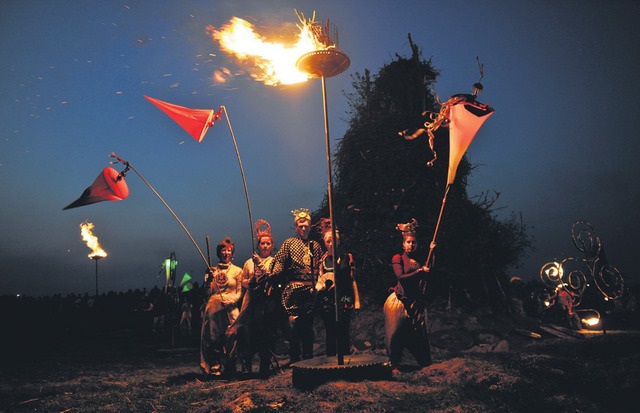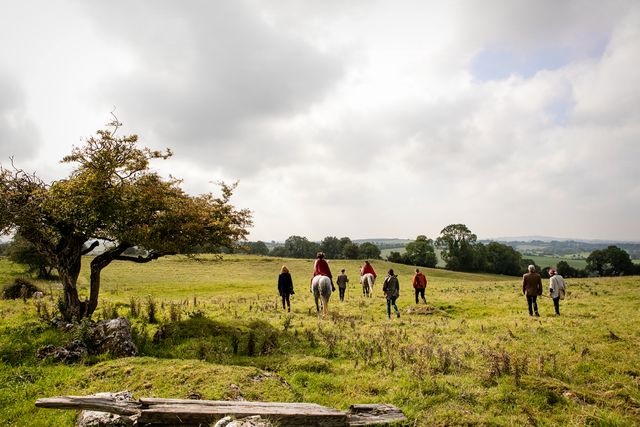Our Celtic Boyne Valley Tour explores some of the most spiritual and sacred parts of Ireland. Irelands ancient east really is the most exceptional areas in the county. The land is scattered with iconic historical and sacred landmarks that make up our ancient past. Our guides will provide you with all the Celtic history that you will need to know, any questions are welcomed by our guides, they would be happy to help. The green landscape of this Celtic region mixed together with the ancient monuments and structures that you will view on this tour makes it an incredible experience! The Hill Of Uisneach is one of the stops on our tour that will really make you appreciate that beauty of Ireland.
It is said that the hill of Uisneach is one of the most spiritual and ancient sites in Ireland. The hill of Uisneach sits 596ft above sea level, and shows extensive panoramic views over the land with twenty counties visible on the horizon. It was also the ancient seat of the Kings of Meath and its historical roots go back to The Iron Age. Along with the main Hill, there are also nearly 20 pre-historic monuments to view.

Let’s get into the long, spiritual history of the site. The Hill of Uisneach is located on the road to Ballymore, about nine miles west of Mullingar. It is just over 600 feet above sea level and has a central place, historically, geographically and metaphorically in Ireland’s history. Traditionally Uisneach was the epicentre of Ireland where the five provinces met. Here you can view a complex set of monuments spread over two square kilometres and has received little attention since it was excavated in the 1920s. It includes enclosures and barrows, a megalithic tomb and two ancient roads. Uisneach is the burial site of the Earth Goddess Ériu & the Sun God Lugh and as such was regarded as sacred ground. Uisneach was seen as a gate to the mythical fifth province, Mide. For centuries, the Mide or ‘The Stone of Divisions’ a sacred, fissured and fragmenting limestone boulder on the south west slope of the Hill. This huge six metre, thirty tonne boulder symbolises Ireland united in its divisions. Now it is the most famous of over forty surviving features on Uisneach, although it is more commonly known as the ‘Catstone’, named so because it resembles a cat watching a mouse.

This was the obvious place to be the seat of the high kings. It was used for scared ceremonies and important marriages. Uisneach was said to be the place that divided Ireland into ‘knowledge in the West, battle in the North, prosperity in the East, music in the South and Royalty at the Centre.’ When Tara later became the seat of the High Kings, Uisneach was still the royal centre of Ireland – the meeting point of the ancient provinces where laws were struck and divisions agreed. It was linked to Tara by a ceremonial road, a section which can still be seen today.

The conjoined ring fort was confirmed to be Uisneach’s royal legacy. One of the palaces’ of King Tuathal Techtmar in the First Century AD, as well as the O’Neill and Colman clans in later years, it was revealed to be an opulent palace during archaeological digs in the 1920′s. Dagda, the good God and leader of the Tuatha De Dannan, also lived here. His ‘solar horses’ stables lie on the north flank of the hill, it was an incredible find for the archaeologists. Lough Lugh, which is the hill top lake near Uisneach is said to be the spot where Lugh, the god of Harvest met his mortal end. The nearby prominent mound “Carn Ludach” is known as the place of his burial. St. Patrick visited in the 5th century intent on establishing a church on this most sacred of sites. He was opposed in his mission by the O’Neill clan but he did manage to put a curse on the stones of Uisneach.
One of the more famous legends that Uisneach holds is that it was the location for the first great fire to be lit in Ireland. It is said that on the first dawn of summer in May, the Uisneach hearth burned biggest and brightest of all; visible to over a quarter of Ireland! At the time Ireland put out all fires in the light of the one that burned the brightest upon the hill, Uisneach’s Bealtaine fire. This ancient fire became the catalyst for the Bealtaine festival, an annual gathering and fair at Uisneach that continues today! As well as continuing to feature a giant bonfire, goods were exchanged and gifts offered to the Gods. Feasting, dancing, music, tournaments and trade were all avidly partaken in as the festival proceeded. It became customary to drive cattle through two fires as a preservative to shield them from diseases and accidents.
The site is still undergoing archaeological digs and is being constantly being studied. As well as studying the twenty or so archaeological monuments that can still be seen on the hill, they have carried out extensive geophysical surveys which have revealed a wealth of buried archaeological remains that shed important new light on Uisneach’s history and role as a ceremonial centre in prehistory.

Hop on the coach with us to Irelands ancient east to immerse yourself in the counties that have been painted with deep history and spirituality. We will also be visiting The Loughcrew passage tomb. This ancient tomb has been around since 3300BC and is 500 years older than new grange. This spectacular tomb site is ours to explore, inside the tomb there are ancient intricate art works that tells the tale of Ireland’s ancient history. Next it’s on to Trim Castle which is the largest Anglo-Norman castle in Ireland and was constructed over a thirty-year period by Hugh de Lacy and his son Walter. This breath-taking twenty-sided tower was protected by a ditch, curtain wall and moat when it was in use. Last but not least is the Hill of Tara, It was the once the ancient seat of power in Ireland and it was said that nearly 140 kings reigned there. It was also site of the ancient gods. The sites from the top of the hill are some of the most beautiful sites in the country, it is claimed that features in half the counties of Ireland can be seen from the Hill Of Tara. Join the adventure with us and book today!

